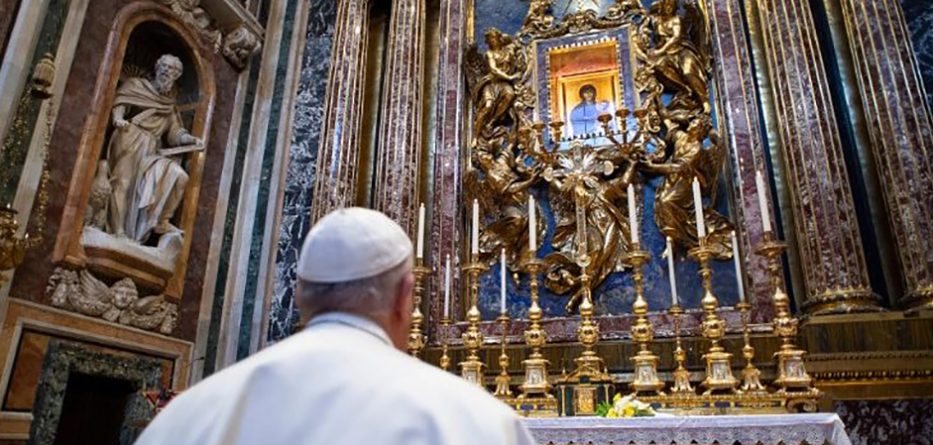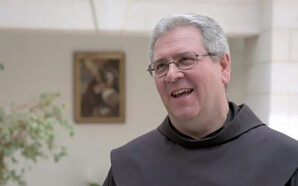The first Jesuit pope in history will eventually be the eighth Roman Pontiff entombed in St Mary Major, joining – among others – the Church’s very first Franciscan pope
History’s first-ever pope from the Americas will one day be laid to rest in a Roman basilica that boasts a magnificent coffered ceiling that was gilded with the first gold that Christopher Columbus brought back from what was once called the New World.
That’s just one of many fascinating bits of trivia surrounding Pope Francis’ recent disclosure that he plans to be buried in the Basilica of Saint Mary Major on Rome’s Esquiline Hill rather than in St. Peter’s Basilica at the Vatican.
The Argentine pope first shared the news in an interview with a Mexican television network on the December 12th Feast of Our Lady of Guadalupe, just days before his 87th birthday on December 17, the Third Sunday of Advent.
“Salus Populi Romani”
Santa Maria Maggiore, as the basilica is called in Italian, seems to be the pope’s favorite church in the Eternal City. Even when he was auxiliary bishop and then cardinal-archbishop of Buenos Aires in the two decades leading up to his election to the papacy in March 2013, Jorge Mario Bergoglio SJ would visit St Mary Major each time he came to Rome. He would make a pilgrimage to the Pauline Chapel to the left of the main altar to pray before an ancient Byzantine icon of the Blessed Virgin Mary fondly known as Salus Populi Romani (figuratively, protectress of the Roman people). And since becoming pope, he’s been back to pray before the beloved image more than 100 times.
This strong devotion to the Salus Populi Romani icon may be the main reason why Francis has decided to be entombed in St Mary Major, but it is probably not the only one. And, furthermore, the icon is not the only element that closely links him to the Marian basilica.
An outsider pope to buried outside the Vatican
It is probably not surprising to anyone who has followed his pontificate even remotely that Francis would choose someplace other than St Peter’s for his final resting place. He bucked convention on the very first the day after he was elected Bishop of Rome nearly eleven years ago, deciding not to move into the apartment in the Apostolic Palace where all his predecessors of the last hundred or so years lived. Instead, he opted to stay in the Casa Santa Marta, a priest residence that John Paul II constructed to house the cardinals during a papal conclave.
What may surprise some people, however, is that Francis has not chosen to be buried in Rome’s Cathedral-Basilica of St John Lateran, given his preference to use his title “Bishop of Rome” (which is actually his most important) rather than any of the other titles the Roman Pontiffs have accrued down the centuries. And while he uses the Lateran as the dateline for a good number of his documents and letters, he has rarely visited his cathedral or celebrated liturgies there — not even during Holy Week, which is generally expected of ordinaries of Catholic dioceses around the world. And, then again, Francis is a Roman outsider. He’s the first pope since St Pius X, who reigned from 1903-1914, who never studied or worked in Rome or the Vatican. So his decision to be buried elsewhere makes even more sense.
Joining six other popes at St Mary Major
Pope Francis will not be the first pope to be buried at Santa Maria Maggiore. Six others have already preceded him. The very first one was Honorius III, pope from 1216-1227, although his tomb is now extant. The “mild, peace-loving pontiff”, as one historian has described him, was a long-time Roman Curia official who attempted a pastoral reform of the Church. He did this by relying on two new religious orders who statutes and rules he approved — the Franciscan and the Dominicans.
Some six decades later, a Franciscan friar actually became pope, and his tomb is also in St Mary Major. Thus, Nicholas IV (reign:1288-1292), history’s first-ever Franciscan pope will be joined by its first-ever Jesuit pope. Elected in a conclave held at Basilica of Santa Sabina, the Dominican church on the Aventine Hill, Nicholas was “a friar and lover of peace” who had served as the Franciscan Minister General, following Saint Bonaventure. As pope, Nicholas had plans, like Francis, to reform the Roman Curia. But his solution was to transfer its offices to the town of Rieti some 80 km north of the Eternal City!
Surprising links to an unexpected predecessor
The most famous pope to be entombed in the Marian basilica on the Esquiline and the only one who has officially been declared a saint is Saint Pius V (r. 1566-1572). A Dominican who served as the “grand inquisitor”, he is best known — among other things, like excommunicating Queen Elizabeth I of England — for having codified the Latin liturgical rite (known as Tridentine), which immediately followed the Council of Trent and was used up until reforms mandated by the Second Vatican Council (1962-65).
There are a couple of interesting elements that link Saint Pius and Pope Francis. First of all, Pius is the only pope to come from Piemonte, except for the fact that the first Latin American pope in history is actually full-blooded “Piemontese”. He may have been born and raised in Argentina, but both of his parents were immigrants from this northern Italian region. Presumably like Pius, not a drop of Latino blood in Francis. Another interesting tidbit: the sainted Dominican pope erected the Diocese of Cordoba in 1570, that’s the place in Argentina where Jesuit headquarters in Rome exiled Jorge Mario Bergoglio in the mid-1980s some years after his turbulent term as provincial superior. Francis has said the experience taught him humility.
The tomb of Pius V is located in a large space to the right the main altar in St Mary Major known as the Chapel of the Blessed Sacrament or the Sistine Chapel, named for the other pope buried in a wall on that side of the basilica, the notorious Sixtus V (r. 1585-1590). A Conventual Franciscan who had been exiled from Rome, he returned with a vengeance and became known as er papa tosto. That’s a colorful phrase in Roman dialect that might best be rendered (for a polite audience) as “the hard-nosed pope”. Sixtus reigned just five years but, more than any other pope in the modern period, he reshaped the papacy, limited the powers of the consistory of the cardinals, and designed the Roman Curia, the structure of which remains today. He also rebuilt much of central Rome and turned what was a lawless city into a police state, ruling with an iron fist. Sixtus also named St. Bonaventure a Doctor of the Church.
More Jesuit connections
The next pope to be interred in Santa Maria Maggiore was Clement VIII (r. 1592-1605), who acted kindly towards the Society of Jesus and in 1595 approved the process that would eventually lead to the beatification of its founder, Ignatius of Loyola (d. 1556). In fact, it was in this basilica that the Jesuit leader offered his first Mass in 1538. Leo XI of the Medici family was elected as Clement’s successor, but he died after a brief 26-day reign and was buried in a lavish mausoleum in St Peter’s Basilica. So the cardinals had to gather again in conclave in early May 1605. Had the king of Spain not vetoed him, Robert Bellarmine, the brilliant theologian who is now a saint and Doctor of the Church, would have preceded Francis as history’s first Jesuit pope. Instead, Camillo Borghese of the famous aristocratic family of Rome, was elected.
He called himself Paul V (r. 1605-1621), a name that is not only seen on countless buildings in the Urb, including the facade of St Peter’s Basilica at the Vatican, it is also the name of the chapel where Pope Francis will be buried — the Pauline or Borghese Chapel. Like Pius V, he also once headed the Roman Inquisition. Papa Borghese, like Clement VIII, was favorable to the Jesuits and even encouraged them to translate the Bible into Chinese. He was the one who eventually beatified Ignatius of Loyola in 1609. And how about this: it was Paul V who, in 1620, established the Diocese of Buenos Aires.
The last pope to be buried in St Mary Major was Clement IX (r. 1667-1669). An alumnus of a Jesuit school and then a canon of this same basilica, he served as Vatican Secretary of State. And his connection with Pope Francis? A concern for the poor. It said that each day during his brief pontificate Clement invited twelve poor people to join him for his midday meal.
Reproduced with permission from La Croix International.








